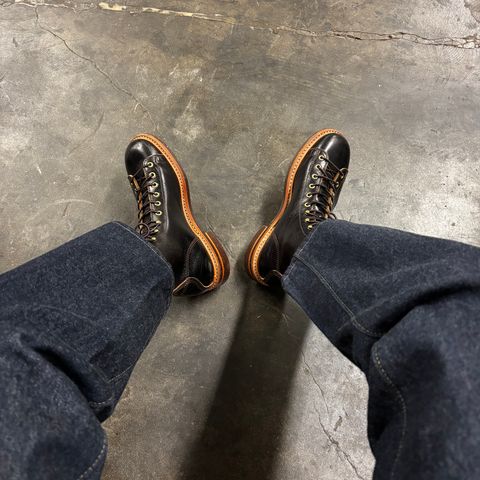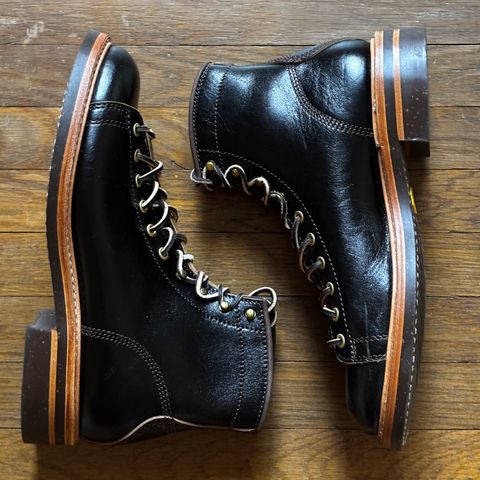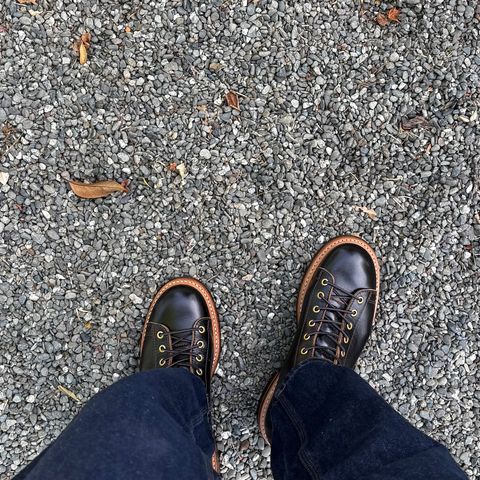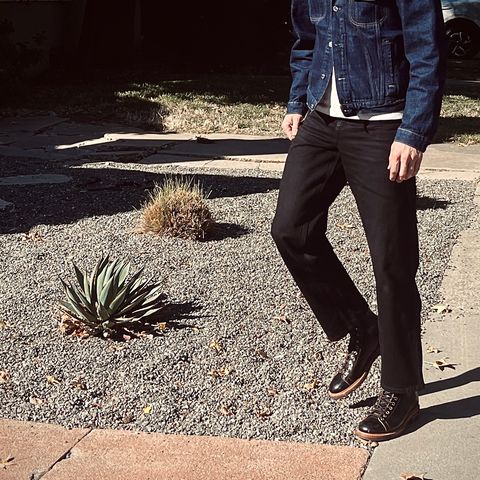About
John Lofgren - Shinki Wabi-Sabi Horsebutt is a limited edition leather developed as an exclusive collaboration between John Lofgren Bootmaker and Shinki Hikaku tannery in Japan. The leather represents an interpretation of the Japanese aesthetic philosophy of wabi-sabi, which finds beauty in imperfection, impermanence, and incompleteness. This exclusive horsebutt leather emphasizes the natural characteristics and authentic markings acquired during the animal's life, celebrating variations rather than concealing them through heavy surface treatment.
About
John Lofgren - Shinki Wabi-Sabi Horsebutt is a limited edition leather developed as an exclusive collaboration between John Lofgren Bootmaker and Shinki Hikaku tannery in Japan. The leather represents an interpretation of the Japanese aesthetic philosophy of wabi-sabi, which finds beauty in imperfection, impermanence, and incompleteness. This exclusive horsebutt leather emphasizes the natural characteristics and authentic markings acquired during the animal's life, celebrating variations rather than concealing them through heavy surface treatment.
The Wabi-Sabi designation distinguishes this leather from standard Shinki Oiled Horsebutt offerings through its philosophical approach to leather finishing. The production preserves natural grain patterns, life marks, and surface variations that embody the wabi-sabi aesthetic principle of embracing authentic imperfection.
Exclusive Development
The collaboration between John Lofgren Bootmaker and Shinki Hikaku for Wabi-Sabi horsebutt represents a specialized partnership combining Japanese bootmaking craftsmanship with Japan's finest horsehide tannery. This exclusive arrangement allows John Lofgren to offer a distinctive leather option that aligns with traditional Japanese aesthetic values while meeting the technical requirements for heritage boot construction.
The development of Wabi-Sabi horsebutt required close collaboration between John Lofgren's design philosophy and Shinki Hikaku's leather finishing expertise. The partnership focuses on minimal intervention finishing that preserves the leather's natural story while ensuring the material meets performance standards for premium footwear applications.
Aesthetic Philosophy
Wabi-Sabi Principles
The wabi-sabi aesthetic philosophy originated in Japanese tea ceremony culture and emphasizes finding beauty in the natural cycle of growth and decay. When applied to leather production, this philosophy celebrates characteristics typically minimized in conventional leather finishing, including natural grain variations, subtle color inconsistencies, and marks from the animal's life experience.
The Wabi-Sabi horsebutt interpretation embraces these principles by preserving authentic surface characteristics rather than applying heavy correction treatments. Bug bites, scratches from tree branches, and other life marks remain visible as cherished enhancements that contribute to each hide's unique narrative.
Natural Character Preservation
Shinki Hikaku applies minimal surface correction to Wabi-Sabi horsebutt, allowing the leather's inherent characteristics to define its appearance. This approach contrasts with conventional leather finishing that prioritizes uniformity through sanding, buffing, and heavy topcoat applications. The preservation of natural grain patterns creates distinctive visual texture that makes each hide fundamentally unique.
The grain structure variability means that boots made from Wabi-Sabi horsebutt differ substantially from pair to pair. This variation is intentional, reflecting the wabi-sabi principle that authenticity and individuality hold greater value than standardized perfection.
Production and Characteristics
Base Material and Tanning
Wabi-Sabi horsebutt begins with the same foundation as other Shinki oiled horsebutt leathers, sourced from European horse butts and processed through vegetable tanning using mimosa bark. The tanning cycle extends approximately four months, allowing the leather to develop its characteristic dense fiber structure and natural grain definition.
The vegetable tanning process using mimosa bark creates a stable foundation that accepts the minimal finishing treatment while maintaining structural integrity. The extended tanning and curing periods produce leather with approximately 30 percent volume loss as the material shrinks and stabilizes.
Finishing Treatment
Following the tanning and curing stages, Wabi-Sabi horsebutt undergoes oil infusion finishing consistent with Shinki's oiled horsebutt production. The oil content exceeds 15 percent of the leather's weight, reinforcing fibers and providing resistance to cracking and hardening. The oil treatment contributes to the leather's soft hand feel from initial use.
The distinguishing characteristic of Wabi-Sabi finishing lies in the minimal surface intervention applied after oil treatment. Where standard leather finishing might include multiple stages of grain correction, buffing, and surface coating, the Wabi-Sabi approach preserves the leather's natural surface topology. This minimal intervention philosophy allows authentic characteristics to remain visible and prominent.
Aniline Finish Application
Shinki applies an aniline finish to Wabi-Sabi horsebutt that showcases rather than conceals the natural grain structure. The aniline treatment involves transparent dye that penetrates the leather without forming an opaque surface coating. This finishing method permits full visibility of natural characteristics including veins, subtle blemishes, and the varied grain patterns that make each hide distinctive.
The aniline finish allows the leather to interact directly with environmental factors, supporting the development of natural patina as the boots accumulate wear. The absence of heavy topcoats means that the leather's surface responds authentically to handling, moisture exposure, and mechanical stress.
Material Properties
Grain Patterns and Surface Texture
Wabi-Sabi horsebutt displays the characteristic honeycomb wrinkle patterns typical of horse butt leather, with grain structure tighter and more regular than comparable cowhide. The minimal surface correction preserves the natural variations within individual hides, creating visual texture that ranges from smooth areas to sections with pronounced grain definition.
The grain patterns vary substantially between different sections of each hide and across different hides. This variability reflects the natural distribution of fiber density and the specific life history of each animal. The wabi-sabi aesthetic framework recontextualizes this variation as desirable authenticity rather than material inconsistency.
Density and Physical Structure
The leather maintains the dense fibrous tissue structure characteristic of horse butt sections, with full-grain surface integrity preserved through the minimal finishing approach. Despite the density, the material retains flexibility and suppleness while maintaining firmness. The combination of dense fiber structure and high oil content creates material resistant to splitting and structural degradation.
Thickness typically measures approximately 3 ounces (1.2mm), though specific production runs may vary. The dense fiber arrangement provides greater sturdiness in the grain side compared to cowhide of similar thickness, while the overall material remains highly flexible for shaping during boot construction.
Performance Characteristics
Durability and Wear Resistance
Wabi-Sabi horsebutt demonstrates strength and resistance to wear consistent with other Shinki oiled horsebutt leathers. The dense fiber structure combined with oil reinforcement creates material that withstands significant use without structural damage. The vegetable tanning foundation and oil treatment provide resistance to perspiration, water exposure, and general environmental staining.
The minimal surface finishing does not compromise durability characteristics. The aniline finish penetrates sufficiently to provide color stability while allowing the leather's natural resilience to function without restriction from heavy surface coatings.
Water Resistance
The high oil content provides inherent moisture resistance, with oil-infused fibers shedding water while maintaining breathability. This characteristic makes Wabi-Sabi horsebutt suitable for footwear exposed to varied weather conditions, consistent with the performance of other oiled horsebutt leathers from Shinki Hikaku.
Aging and Patina Development
Natural Wear Patterns
Wabi-Sabi horsebutt develops patina characteristics that enhance the leather's natural appearance while reflecting individual use patterns. The aniline finish allows the natural grain to darken and develop sheen in high-wear areas without resistance from heavy topcoats. Lines and wrinkles that form during use become more pronounced over time, creating visual records of the boots' service history.
The patina development occurs more rapidly than with heavily finished leathers, as the minimal surface treatment allows direct environmental interaction. The vegetable tanning process combined with aniline finish enables the material to develop unique patina patterns that reflect the wearer's specific usage, embodying the wabi-sabi principle of beauty emerging through time and use.
Color Evolution
The natural color evolution varies based on exposure patterns, handling frequency, and environmental conditions. High-wear zones typically develop deeper, richer tones as the leather compresses and oils migrate to the surface. Areas subjected to repeated flexing may show subtle lightening where grain patterns stretch and relax through the wear cycle.
This natural aging process creates visual complexity that increases over extended periods, making aged Wabi-Sabi horsebutt boots substantially different in appearance from new examples. The philosophy underlying the leather selection celebrates this transformation as enhancement rather than degradation.
John Lofgren Applications
Combat Boot Construction
John Lofgren has produced Wabi-Sabi horsebutt specifically in Combat Boot styling, applying the leather to the classic perforated cap-toe military boot design. The Combat Boot silhouette provides substantial surface area that showcases the leather's natural grain variations and authentic markings.
The construction employs John Lofgren's standard Japanese craftsmanship methods, including Goodyear welt construction with premium components. The boot assembly process respects the leather's natural characteristics, with craftsmen selecting and positioning hide sections to emphasize rather than minimize the variations that define the Wabi-Sabi aesthetic.
Limited Edition Status
The Wabi-Sabi edition represents a very limited production run, with boots appearing primarily through secondary markets rather than regular production offerings. This limited availability reflects both the specialized nature of the leather finishing philosophy and the exclusivity of the John Lofgren-Shinki Hikaku collaboration for this particular aesthetic interpretation.
The limited edition status contributes to the leather's appeal among collectors and enthusiasts who appreciate both the philosophical foundations and the distinctive visual characteristics. Pricing reflects the premium positioning, with secondary market values exceeding $1,150 for examples in good condition.
Cultural Significance
Heritage Footwear Context
The Wabi-Sabi horsebutt offering represents an intersection of Japanese aesthetic philosophy with heritage footwear manufacturing. This connection appeals to customers who value the cultural depth underlying material selections and appreciate leather that carries philosophical meaning beyond functional performance.
The emphasis on natural characteristics and authentic imperfection aligns with broader trends in heritage footwear toward materials that develop individual character through use. The wabi-sabi framework provides cultural and philosophical justification for celebrating variations that conventional leather finishing would minimize or eliminate.
Authenticity and Individuality
The preservation of natural markings and grain variations ensures that each pair of boots made from Wabi-Sabi horsebutt differs substantially from other examples. This guaranteed uniqueness appeals to consumers seeking individual expression through material authenticity rather than artificial customization.
The philosophical underpinnings elevate the leather selection from simple material choice to an aesthetic statement. Wearing boots made from Wabi-Sabi horsebutt signals appreciation for Japanese cultural values, acceptance of natural imperfection, and preference for materials that honestly express their origins and service history.
Care and Maintenance
Conditioning Approach
Proper care of Wabi-Sabi horsebutt follows standard protocols for vegetable-tanned oiled leather while respecting the minimal finishing philosophy. Conditioning should occur every 3-4 months under normal wear conditions, using high-quality neutral products that nourish the leather without adding tinting agents or heavy waxy buildups that would obscure the natural surface characteristics.
The conditioning products should be selected to support the aniline finish and natural grain visibility. Heavy conditioners or products with substantial pigment content may interfere with the authentic appearance that defines the Wabi-Sabi aesthetic approach.
Cleaning and Protection
Regular brushing with quality horsehair brushes maintains surface consistency while protecting the leather from accumulated debris. The minimal surface finish means the leather interacts directly with environmental factors, making regular cleaning important for preventing embedded soiling that might affect appearance development.
Water exposure should be managed through prompt drying at room temperature with proper boot tree support. While the high oil content provides moisture resistance, the aniline finish lacks the water-repelling properties of heavily coated leathers. Natural drying preserves the leather's structural integrity and supports continued patina development.
Exclusivity and Availability
The exclusive nature of this limited edition partnership means Wabi-Sabi horsebutt was available only through John Lofgren Bootmaker production. The specialized aesthetic philosophy and limited production runs make this leather particularly rare compared to standard Shinki oiled horsebutt offerings.
Current availability exists primarily through secondary markets, where boots featuring Wabi-Sabi horsebutt appear occasionally among collectors and enthusiasts. The combination of limited original production, distinctive aesthetic philosophy, and premium John Lofgren construction maintains strong interest and value retention.
References
"Shinki Hikaku Horsebutt Leather Collection". John Lofgren Bootmaker. Retrieved October 11, 2025.
"MONKEY BOOTS / SHINKI HIKAKU HORSEBUTT TIMBER". John Lofgren Bootmaker. Retrieved October 11, 2025.
"STEEL GANG BOOTS / SHINKI HIKAKU HORSEBUTT DARK BROWN". John Lofgren Bootmaker. Retrieved October 11, 2025.
"John Lofgren Shinki Hikaku 'Wabi-Sabi' Horse butt Combat Boots very LE". eBay. Retrieved October 11, 2025.






















































